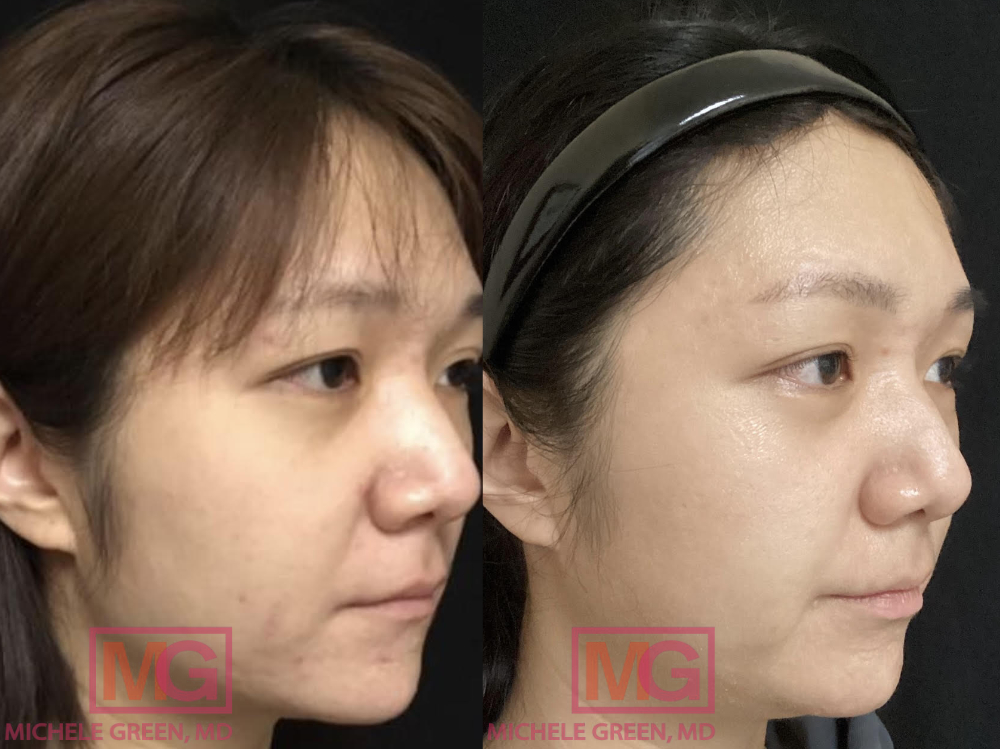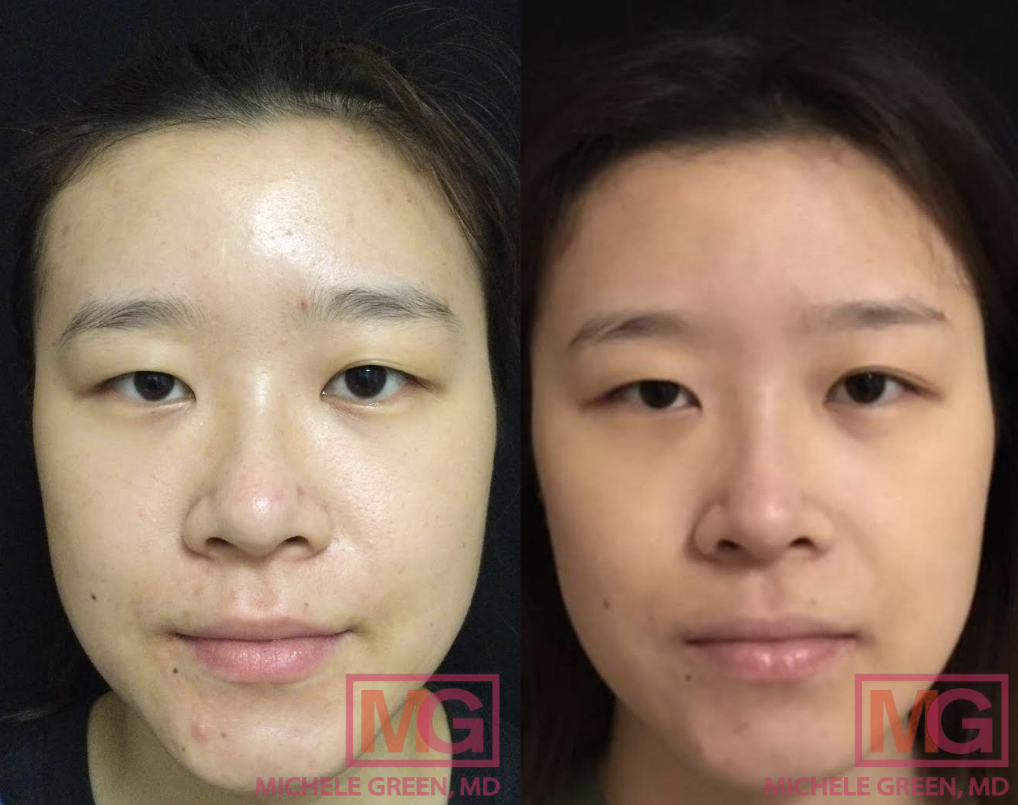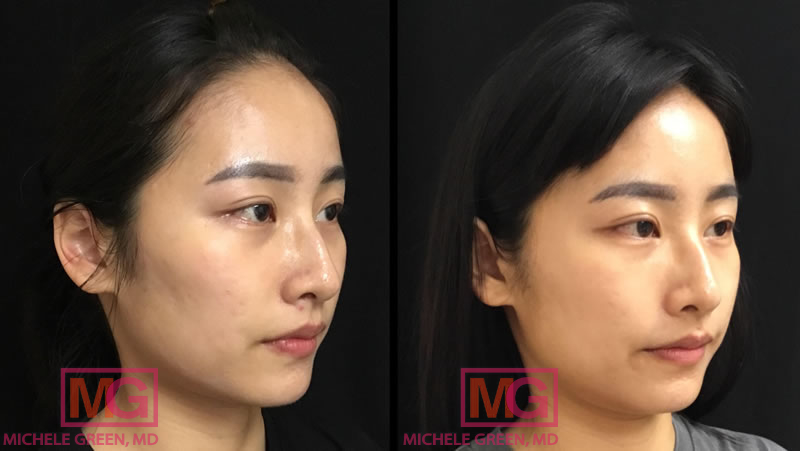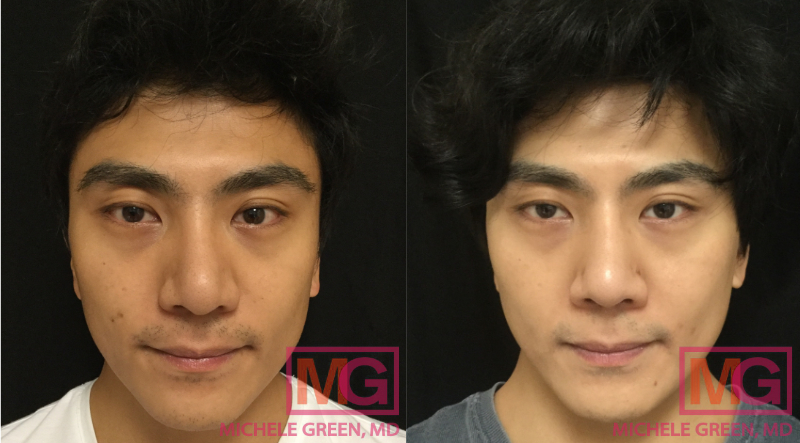Acne Scar & Acne Treatment for Asian Skin
Acne is one of the most common skin conditions in the world, and it is estimated that one in every five individuals with acne breakouts will develop acne scars. There are many treatment options for targeting blemishes and reducing acne scarring, including chemical peels, laser treatments, specially formulated skincare products, and more. To attain optimal results and prevent unwanted side effects, it is crucial that the treatment options selected for your rejuvenation plan are appropriate for your skin type and skin tone. To guarantee the best results regarding acne and acne scar treatment, it is always recommended to consult with an experienced board-certified dermatologist, such as Dr. Michele Green in NYC. Dr. Green has over 25 years of experience treating patients of all skin tones and types and will customize your treatment plan to help you safely and effectively achieve smooth, clear, healthy skin that lasts.
Asian skin is particularly sensitive compared to other skin types, meaning that some traditional acne treatments may be far too irritating for Asian skin. In addition, Asian skin is more likely to be affected by post-inflammatory hyperpigmentation (PIH). Post-inflammatory hyperpigmentation is a skin condition characterized by the formation of dark spots due to increased melanin production during the skin’s natural healing process. In Asian skin, PIH may develop due to an acne breakout or as an unwanted side effect of some traditional acne and acne scar treatment options. This is why working with an experienced board-certified dermatologist who knows what is safe and effective for your skin type is imperative. When you consult with Dr. Green, she will work with you to create a customized acne treatment plan that includes specialized skin care products, any necessary topical and oral medications, and in-office procedures best suited to your skin type and tone.
Dr. Michele Green is an internationally renowned board-certified dermatologist with over two and a half decades of experience providing some of the world’s most discerning individuals with the best treatment options, including acne breakouts and scars. She is consistently identified as one of New York City’s best dermatologists by Castle Connolly, New York Magazine, Super Doctors, and the New York Times for her dedication to her patients and expertise. When you consult with Dr. Green at her private dermatology office in Manhattan’s Upper East Side neighborhood, she will work with you to develop a customized treatment protocol that best suits your skin type, particular skin concerns, skin tone, and overall aesthetic goals.

Acne Scar Treatment and Asian Skin
Acne vulgaris, commonly known as acne, is one of the most common skin conditions affecting millions of people of all skin types and skin tones worldwide. Characterized by blemishes and pimples on the skin’s surface, acne breakouts can occur anytime in life, even beyond adolescence. Hormone fluctuations, high levels of sebum production, and an improper skincare routine can lead to clogged pores and acne breakouts, leading to inflammatory acne and even acne scars when left untreated. Inflammatory acne occurs when the pores become clogged with bacteria, which causes damage to the skin, impeding the healing process and leading to scarring. Acne scars can be depressed (atrophic), raised (hypertrophic), or discolored, and can be a source of distress for patients long after the initial acne breakout has cleared. Luckily, many acne and acne scar treatment options are completely safe and effective for all skin types, including Asian skin.
The most effective way to save the skin from acne scarring is to take preventative measures with early acne treatment. Many skincare products are available to maintain clear skin and manage excess oil production by hydrating and cleansing with non-comedogenic cleansers, toners, and moisturizers. Topical treatments, including retinoids, can help to dry out the pores, preventing excess oil production and reducing inflammation from an active breakout. Chemical peels containing glycolic acid and salicylic acid can help to safely and gently exfoliate Asian skin to clear the pores of dead skin cells and other debris to combat acne breakouts. Chemical peels also effectively treat acne scars, promoting skin cell turnover for a more even skin texture and tone. While some laser treatments can be dangerous for Asian skin, others, such as the VBeam laser and eMatrix laser, are safe and effective at combatting the appearance of acne scars and pigmentation.
Regarding acne and acne scar treatment for Asian skin, the most crucial step is finding a dermatologist who is an expert in treating all skin tones, such as Dr. Michele Green. Due to the concentration of melanin in the skin, Asian skin is more prone to post-inflammatory hyperpigmentation or the formation of dark spots due to specific treatments, including laser treatments like intense pulsed light (IPL) and certain exfoliants and topical creams. Further, there is much diversity among people of Asian descent, and the treatments that will be safe for some members of the population may not be safe for others, so seeking a healthcare provider who knows what is safe and effective for your skin type is imperative. Board-certified dermatologist Dr. Michele Green has been expertly treating patients of all races and ethnicities in her Upper East Side New York City dermatology office for more than 25 years. Well-known for high patient satisfaction, Dr. Green is frequently voted one of the best healthcare providers in New York City by such publications as Castle Connolly, Super Doctors, and New York Magazine.
What are the types of acne blemishes?
Acne patients may experience several acne blemishes, including whiteheads, blackheads, papules, pustules, nodules, and cysts. Whiteheads are called closed comedones, characterized by white bumps on the skin’s surface. They occur when pores or hair follicles become clogged with oil and sebum, but the follicle remains closed. Blackheads, on the other hand, are open comedones and are black due to the reaction between the excess oil and the skin. When clogged pores become inflamed, they may be papules, acne blemishes characterized by small, tender pink bumps that do not contain pus, or pustules, which are pus-filled and take on a yellow or white appearance. When bacteria gets trapped in the pores, nodules or cysts may form, typically the most painful type of acne and the most prone to developing acne scars. Nodules are lesions that form deep under the skin, leading to painful bumps on the surface. Cysts also form deep under the skin but differ in that they are filled with pus. Knowing which type of acne you are dealing with is essential in finding the acne treatment plan that will be the most effective.

How to get rid of acne for Asian skin
The best way to prevent acne scarring is to treat active acne breakouts as soon as possible, and many treatment methods are effective for Asian skin.
Topical Treatments – Topical treatments for acne breakouts often work to control the production of sebum on the skin and to unclog the pores. Retinol and benzoyl peroxide creams dry out the skin to reduce oil production and have anti-inflammatory properties. A study in Japan showed that topical 2% nicotinamide decreases the sebum production rate, which helps reduce facial acne. Additionally, pimple patches are a well-regarded part of the Korean skincare routine, particularly the Cosrx Master Patch – Intensive. This spot treatment can be placed over the pimple to reduce inflammation. While topical creams are often quite effective at clearing acne, one common side effect is that the skin can become irritated, meaning that acne patients should be deliberate about moisturizing the skin during treatment.
Chemical Peels & Exfoliants – Chemical peels are a popular treatment option at Dr. Green’s dermatology office for many skin conditions, including active acne breakouts. Medium-depth and deep chemical peels can potentially damage Asian skin, so it is essential to consult with Dr. Green about which chemical peel will be safe and effective for your skin. Typically, Dr. Green will start with gentle, light chemical peels such as alpha-hydroxy acid peels (AHA) peels, which contain such ingredients as glycolic acid, or beta-hydroxy acid peels (BHA), which contain such ingredients as salicylic acid. The chemical peel gently exfoliates the skin, clearing away debris, such as excess oil and dead skin cells, and promoting skin cell turnover for clear, bright skin.
Antibiotics – If you struggle with inflammatory acne, the best action may be an antibiotic prescription to kill the bacteria clogging the pores. Antibiotics are anti-inflammatories as well, which help to reduce the appearance of acne blemishes.
When you have your initial consultation with Dr. Green, she will recommend the treatment that will be best for your skin, considering if you have sensitive skin, dry skin, oily skin, or combination skin.
What is the best cleanser for acne-prone Asian skin?
The use of cleanser is an essential part of the skincare routine for all skin types to ensure that your skin is clear of debris. A cleanser should be used morning and night to clear away dirt, excess oil, makeup, dead skin cells, and bacteria on the skin’s surface. Korean researchers found that for acne-prone skin, cleansers that are specifically noncomedogenic, non-acnegenic, oil-free, and nonirritating are effective at reducing acne breakouts and do not cause irritation to the skin. Acne patients with sensitive skin should also avoid cleansers that have fragrances or any exfoliants, as they can irritate the skin.
What is the best toner for acne-prone skin?
Another critical step in your skincare routine is toner, which is often talked about less than cleansers and moisturizers. After cleansing, toner resembles water and is used to hydrate the face and prepare the pores for any further treatments, serums, or sheet masks that will be applied to the face, allowing for better absorption of nutrients and treatments into the skin. Many different kinds of toners work well for different skin types. For patients with oily skin, a toner containing ingredients such as salicylic acid and witch hazel can effectively clean the face without drying the skin. For sensitive skin, the Korean company Cosrx has the AHA/BHA Clarifying Treatment Toner containing ingredients such as willow bark, which helps to gently exfoliate the skin and unclog the pores without irritating the skin.

What do Koreans use for acne?
Korean skincare for acne typically involves gentle, hydrating products containing such ingredients as tea tree oil and niacinamide that are used daily to achieve and maintain clear, healthy, glowing skin. Typically, acne treatment is wrapped up within the 10-step K-Beauty skincare routine and is performed after the toner is applied. Acne treatments for Asian skin can be purchased online from Korea-based K-beauty companies. Still, the Korean skincare routine can also be followed with products available in the United States. The best course of action is to consult with an expert dermatologist, such as Dr. Green, who can examine the treatment area and determine the treatment plan that will be most effective for you.
What is Korean skincare?
Korean skincare is centered around a 10-step skincare routine to achieve and maintain clear, bright, glowing, healthy, youthful-looking skin. The ten steps of the routine are as follows:
- Oil-based cleaner, which is used to remove makeup, sunscreen, and excess oil.
- Water-based cleanser to remove dirt, sweat, and other debris. The two-step cleanser process helps thoroughly clean the skin of oil- and water-based debris.
- Exfoliation should be performed once or twice weekly to remove dead skin cells and promote skin cell turnover.
- Toner to help repair the skin barrier and prepare the pores to absorb treatments
- Essence, serums, and boosters, such as Vitamin C serum that hydrate the skin and contain antioxidants.
- Treatment is the step in which acne treatment occurs and involves applying topical treatments for skin conditions, improving acne breakouts, the appearance of acne scars, and hyperpigmentation, such as rosacea.
- Sheet Masks are a signature part of the Korean skincare routine. Infused with concentrated essence, sheet masks are applied to the face to hydrate and moisturize the skin.
- Eye Creams are applied to the delicate under-eye area to prevent signs of natural aging, like fine lines and wrinkles.
- Moisturizers can be applied in many forms, including creams, gels, and masks, and works to seal in moisture for hydrated skin.
- Sunscreen is the most crucial step in the Korean skincare routine, as proper sun protection is necessary to prevent damage to the skin, such as hyperpigmentation and sun spots. The sun’s UV rays are also a primary cause of premature aging and can dry out the skin, exacerbating the appearance of fine lines and wrinkles.
What are acne scars?
Acne scars form from inflammatory acne and can present as a blemish on the skin long after the initial acne breakout has faded. Several types of acne scars can develop, including atrophic – or depressed – acne scars, hypertrophic – or raised – acne scars, and hyperpigmentation. Atrophic acne scars form when inflammatory acne damages the skin, and the body cannot produce sufficient collagen during the natural healing process, resulting in a depression on the skin’s surface. There are three types of atrophic acne scars: Boxcar scars, which are wide round or oval-shaped depressions with steep sides; Ice pick scars, which are deep depressions that look as though the skin has been pierced with a sharp object; and rolling acne scars, which are characterized by sloping sides and are often found on the lower cheeks and jaw.
On the other hand, hypertrophic scars are raised scars that form due to an overproduction of collagen during the healing process. Often, hypertrophic scars are more significant than the original acne blemish, extending beyond the borders of where the nodule or cyst used to be. Acne scarring can also take on the appearance of hyperpigmentation or discoloration at the site of the acne breakout.
Why is Asian acne scarring common?
The development of acne scars is joint for acne patients who experience severe acne breakouts and inflammatory acne. When acne lesions become clogged with bacteria, the bacteria can cause damage deep under the skin’s surface. Insufficient or too much collagen may be produced when this occurs, leading to atrophic or hypertrophic acne scars. Acne scarring can also appear as hyperpigmentation in the form of pigmentation or dark spots at the breakout area. Asian skin is generally more susceptible to hyperpigmentation than Caucasian skin.
Which acne scars are permanent for Asian skin?
Acne scars do not go away independently and require a dermatologist’s intervention. While atrophic acne scars, hypertrophic acne scars, and hyperpigmentation may be permanent, they can be treated with various treatment options. With the help of such treatments as the VBeam laser, eMatrix laser, dermal fillers, chemical peels, and microneedling, the appearance of acne scars can be significantly reduced.

How to get rid of acne scars for Asian skin
The first step for getting rid of acne scars for Asian skin is to find a dermatologist who is highly experienced in treating Asian skin and skin of color, such as Dr. Green. When you have your initial consultation with Dr. Green, you will discuss your aesthetic goals, and Dr. Green will examine the treatment area to determine the treatment or series of treatments that will best meet your needs. The specific treatment will depend on the type of acne scar and your skin type, as some laser treatments and chemical peels may not be safe for patients with darker skin.
What types of acne scar treatment are available for Asian skin?
Many treatment options available at Dr. Green’s office are safe and effective for patients of Asian descent, including laser treatment, such as the VBeam laser and eMatrix laser, chemical peels, and dermal fillers.
Laser Treatment – Many lasers can treat acne scars, but not all are safe for Asian skin. Patients with a higher concentration of melanin in their skin are at a higher risk of developing post-inflammatory hyperpigmentation as a side effect of some laser treatments, which results in dark spots on the skin’s surface. Two laser treatments that are safe and effective for Asian skin are the VBeam laser and the eMatrix laser. The VBeam laser is a pulsed dye laser that removes redness and pigmentation from skin conditions such as acne scars, hyperpigmentation, and rosacea. It is a non-ablative laser, meaning there is no recovery time necessary, and it is often considered the gold standard for addressing redness and discoloration on the skin. Another safe and effective laser for treating acne scars on Asian skin is the eMatrix laser, which uses bi-polar radiofrequency energy to heat the dermal layer of skin at the treatment area, boosting collagen production and skin cell turnover for more evenly textured skin. Similarly, Picosure is an effective and safe laser to treat Asian skin.
Chemical Peels – Chemical peels are chemical, acid-based solutions applied to the skin and work to exfoliate the treatment area, providing patients with rejuvenated skin. The acid solution reacts with the dead skin cells and other debris on the skin’s surface, causing them to slough off, increasing the skin cell turnover rate and producing a more even tone and texture to the skin. It is best to consult an expert dermatologist before using a chemical peel, as some chemical peels are unsafe for patients with darker skin tones.
Dermal Fillers – When most patients hear “dermal fillers,” they think about lip filler or cheek filler treatment to help contour the face and combat signs of aging; however, dermal fillers can be used to treat acne scars as well, specifically atrophic acne scars. When dermal fillers are injected into a depressed acne scar, they can help to fill in the depression on the skin’s surface, providing patients with smoother skin. Dr. Green has many dermal fillers available in her office, including hyaluronic acid fillers, like the Juvederm and Restylane fillers.
What is the best acne scar treatment for Asian skin?
With several safe and effective treatment options available to eliminate acne scars on Asian skin, knowing which is ” best ” can be challenging.” No one treatment is inherently “better” than another; instead, it is essential to find the treatment that will work best to fit your unique needs and aesthetic goals. Treatment plans are based on the type of acne scar, what will be safe for use on the patient’s skin tone, and each patient’s aesthetic goals.
Is acne common in Asians?
Acne vulgaris is the most common skin condition in the world, affecting more than 9% of the world’s population. Many people think that acne breakouts only affect adolescents, but many adults also suffer from acne vulgaris. Not only can acne breakouts be painful and uncomfortable, but acne can also cause psychological distress. Acne is often quite treatable, but it is essential to find the procedures or skincare products that will work best for your skin type and the type of acne.
Why is Asian acne so bad?
Acne is caused by a build-up of sebum, dead skin cells, and other pore debris, leading to bumps and inflammation on the skin’s surface. Increased skin oil production, known as sebum, can be a risk factor for developing acne vulgaris, as excess sebum can clog the pores. Some research has shown that Asian skin may be more oily than Caucasian skin, increasing the risk of developing acne vulgaris.
How to treat acne for Asian skin
Many treatment options are available to address acne breakouts for Asian skin, including topical creams, chemical peels, and antibiotics. Topical creams containing such ingredients as retinol, benzoyl peroxide, and nicotinamide are highly effective in controlling sebum production on the skin, which helps unclog the pores and clear the skin. Chemical peels exfoliate the skin and promote skin cell turnover, clearing the skin of excess oil and debris that may clog the pores and lead to an acne breakout. Antibiotics kill bacteria that may become trapped in the pores and provide an anti-inflammatory effect. When you consult with Dr. Green, she will recommend the acne treatment that will work best for you.
How to get started with acne scar treatment today
Severe acne breakouts can cause permanent damage to the skin, resulting in acne scars that can be even more difficult to treat than the initial breakout. Acne scars can take several forms, including atrophic acne scars, hypertrophic acne scars, and hyperpigmentation, that require intervention from a cosmetic dermatologist to reduce successfully. Luckily, expert, board-certified dermatologist Dr. Michele Green offers many treatment options at her Upper East Side New York City office for patients of every skin tone and skin type. When treating patients with Asian skin, Dr. Green chooses treatment options that are safe and effective, such as the eMatrix laser and VBeam laser, chemical peels, and dermal fillers. Whether you struggle with active acne breakouts or residual acne scarring, Dr. Green is here to help.
Dr. Michele Green is an internationally renowned board-certified dermatologist with over two and a half decades of experience providing some of the world’s most discerning individuals with the best treatment options available, including acne breakouts and scarring. She is consistently identified as one of New York City’s best dermatologists by Castle Connolly, New York Magazine, and Super Doctors for her dedication to her patients and expertise. When you consult with Dr. Green at her private dermatology office in Manhattan’s Upper East Side neighborhood, she will work with you to create a customized treatment plan that best suits your skin tone, particular skin concerns, skin type, and aesthetic goals. To eliminate the appearance of acne scars and determine the best treatment protocol for regenerating new collagen, removing discoloration, and leaving you with beautiful clear skin, schedule a consultation by contacting Dr. Green online or calling our New York City office at 212-535-3088.
 212-535-3088
212-535-3088